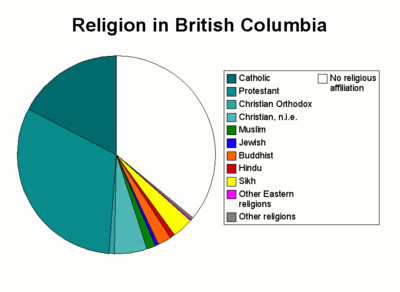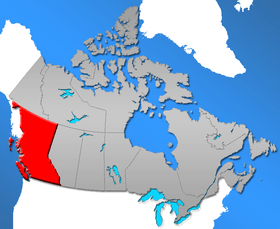Demographics of British Columbia
Population of British Columbia (2011): 4,400,057
Percentage of National Population: 13.2%
Population Growth Rate: 4.9%
Vital statistics
Birth rate: 1.2 births per 1,000 [1] (Canadian average ≈ 11)
Death rate: 2.3 deaths per 1,000
Infant mortality rate: 4.0 deaths per 1,000 live births [2]
Life expectancy at birth: 81.12 years[3]
Total fertility rate: 1.4 children born per woman [4] (Canadian average = 1.61)
Population of British Columbia since 1851
| Year | Population | Five year % change |
Ten year % change |
Rank among provinces |
|---|---|---|---|---|
| 1851 | 55,000 | n/a | n/a | n/a |
| 1861 | 51,524 | n/a | -6.3 | n/a |
| 1871 | 36,247 | n/a | -29.7 | 7 |
| 1881 | 49,459 | n/a | 36.4 | 8 |
| 1891 | 98,173 | n/a | 98.5 | 8 |
| 1901 | 178,657 | n/a | 82.0 | 6 |
| 1911 | 392,480 | n/a | 119.7 | 6 |
| 1921 | 524,582 | n/a | 33.7 | 6 |
| 1931 | 694,263 | n/a | 32.3 | 6 |
| 1941 | 817,861 | n/a | 17.8 | 4 |
| 1951 | 1,165,210 | n/a | 42.5 | 3 |
| 1956 | 1,398,464 | 20.0 | n/a | 3 |
| 1961 | 1,629,082 | 16.5 | 39.8 | 3 |
| 1966 | 1,873,674 | 15.0 | 34.0 | 3 |
| 1971 | 2,184,620 | 16.6 | 34.1 | 3 |
| 1976 | 2,466,610 | 12.9 | 31.6 | 3 |
| 1981 | 2,744,467 | 11.3 | 25.6 | 3 |
| 1986 | 2,883,370 | 5.1 | 16.9 | 3 |
| 1991 | 3,282,061 | 13.8 | 19.6 | 3 |
| 1996 | 3,724,500 | 13.5 | 29.2 | 3 |
| 2001 | 3,907,738 | 4.9 | 19.1 | 3 |
| 2006 | 4,113,487 | 5.4 | 10.4 | 3 |
| 2011 | 4,400,057 | 7.0 | 12.6 | 3 |
- Source: Statistics Canada[5]
Age structure
| Males | Females | |||
|---|---|---|---|---|
| Age Group |
Number | Percent | Number | Percent |
| 0-4 | 105,808 | 2.4% | 100,116 | 2.2% |
| 5-9 | 117,909 | 2.8% | 111,383 | 2.6% |
| 10-14 | 133,809 | 3.1% | 126,388 | 3.0% |
| 15-19 | 143,449 | 3.4% | 136,227 | 3.2% |
| 20-24 | 155,369 | 3.7% | 147,770 | 3.5% |
| 25-29 | 139,521 | 3.3% | 138,299 | 3.3% |
| 30-34 | 144,788 | 3.4% | 145,869 | 3.4% |
| 35-39 | 155,429 | 3.7% | 158,364 | 3.7% |
| 40-44 | 177,381 | 4.2% | 179,216 | 4.2% |
| 45-49 | 172,786 | 4.1% | 177,082 | 4.2% |
| 50-54 | 157,596 | 3.7% | 159,965 | 3.8% |
| 55-59 | 138,096 | 3.2% | 139,772 | 3.3% |
| 60-64 | 101,610 | 2.4% | 103,764 | 2.4% |
| 65-69 | 80,051 | 1.9% | 82,363 | 1.9% |
| 70-74 | 70,060 | 1.6% | 72,493 | 1.7% |
| 75-79 | 54,572 | 1.3% | 64,344 | 1.5% |
| 80-84 | 36,304 | 0.8% | 53,047 | 1.2% |
| 85+ | 24,544 | 0.6% | 48,978 | 1.1% |
| Totals | 2,109,082 | 49.6% | 2,145,440 | 50.4% |
- Source: BCStats[6]
Ethnicity
British Columbia has a very diverse ethnic population, with a large number of immigrants having lived in the province for 30 years or less. First-generation immigrants from the British Isles remain a strong component of local society despite limitations on immigration from Britain since the ending of special status for British subjects in the 1960s. Also present in large numbers relative to other cities in Canada (except Toronto), and also present in BC ever since the province was first settled (unlike Toronto), are many European ethnicities of the first and second generation, notably Germans, Ukrainians, Scandinavians, Yugoslavs and Italians; third-generation Europeans are generally of mixed lineage, and traditionally intermarried with other ethnic groups more than in any other Canadian province. The percentages add to more than 100% because of dual responses (e.g. "French-Canadian" generates an entry in both the category "French" and the category "Canadian"). In recent decades, the proportion of those of Chinese ethnicity has risen sharply, though still outnumbered by the historically-strong population of those of German ancestry. Visible minorities have become an important factor in ethnic-based politics, though most visible minorities are less numerous than the long-standing non-British European ethnicities making up BC's "invisible minorities".
- Further information: Statistics Canada. "Population by selected ethnic origins, by province and territory (2006 Census) (British Columbia)"[7]
Note: The following statistics represent both single (e.g., "German") and multiple (e.g., "part Chinese, part English") responses to the 2006 Census, and thus do not add up to 100%.
| Ethnic Origin | Population | Percent |
|---|---|---|
| English | 1,207,245 | 29.63% |
| Scottish | 828,145 | 20.32% |
| Canadian | 720,200 | 17.67% |
| Irish | 618,120 | 15.17% |
| German | 561,570 | 13.78% |
| Chinese | 432,435 | 10.60% |
| French | 361,215 | 8.86% |
| Indian | 232,370 | 5.70% |
| Ukrainian | 197,265 | 4.84% |
| Dutch (Netherlands) | 196,420 | 4.82% |
| North American Indian | 193,060 | 4.74% |
| Italian | 143,155 | 3.51% |
| Norwegian | 129,420 | 3.18% |
| Polish | 128,360 | 3.15% |
| Russian | 114,105 | 2.80% |
| Welsh | 104,275 | 2.56% |
| Swedish | 104,025 | 2.55% |
- Source: Statistics Canada[8]
Indo-Canadians
Visible minorities and Aboriginal Peoples
- Note: Statistics Canada defines visible minorities as defined in the Employment Equity Act which defines visible minorities as "persons, other than Aboriginal peoples, who are non-Caucasian in race or non-white in colour".
| Visible minority and Aboriginal population (Canada 2011 Census) | |||
|---|---|---|---|
| Population group | Population | % of total population | |
| White | 2,911,295 | 67.3% | |
| Visible minority group Source:[9] | South Asian | 313,440 | 7.2% |
| Chinese | 438,140 | 10.1% | |
| Black | 33,260 | 0.8% | |
| Filipino | 126,040 | 2.9% | |
| Latin American | 35,465 | 0.8% | |
| Arab | 14,090 | 0.3% | |
| Southeast Asian | 51,970 | 1.2% | |
| West Asian | 38,960 | 0.9% | |
| Korean | 53,770 | 1.2% | |
| Japanese | 38,120 | 0.9% | |
| Visible minority, n.i.e. | 6,465 | 0.1% | |
| Multiple visible minority | 31,160 | 0.7% | |
| Total visible minority population | 1,180,870 | 27.3% | |
| Aboriginal group Source:[10] | First Nations | 155,020 | 3.6% |
| Métis | 69,475 | 1.6% | |
| Inuit | 1,570 | 0% | |
| Aboriginal, n.i.e. | 3,745 | 0.1% | |
| Multiple Aboriginal identity | 2,480 | 0.1% | |
| Total Aboriginal population | 232,290 | 5.4% | |
| Total population | 4,324,455 | 100% | |
Religions

| Population by religion, Canada and BC (2001 Census) |
Canada | B.C. | ||
|---|---|---|---|---|
| number | % | number | % | |
| Total population | 29,639,035 | 3,868,875 | ||
| No religious affiliation | 4,900,090 | 17% | 1,388,300 | 36% |
| Protestant | 8,654,850 | 29% | 1,213,295 | 31% |
| Catholic | 12,936,905 | 44% | 675,320 | 17% |
| Christian not included elsewhere | 780,450 | 3% | 200,345 | 5% |
| Sikh | 278,410 | 1% | 135,310 | 3% |
| Buddhist | 300,345 | 1% | 85,540 | 2% |
| Muslim | 579,640 | 2% | 56,220 | 1% |
| Christian Orthodox | 479,620 | 2% | 35,655 | 1% |
| Hindu | 297,200 | 1% | 31,500 | 1% |
| Jewish | 329,995 | 1% | 21,230 | 1% |
| Eastern religions | 37,550 | 0% | 9,970 | 0% |
| Other religions | 63,975 | 0% | 16,205 | 0% |
| Source: Statistics Canada 2001 Census http://www40.statcan.ca/l01/cst01/demo30c.htm | ||||
Languages
| Language(s) first learned and still understood | Total | % | Male | Female |
|---|---|---|---|---|
| English only | 2,825,780 | 73.03% | 1,403,230 | 1,422,545 |
| French only | 54,405 | 1.41% | 27,340 | 27,060 |
| Both English and French | 6,784 | 0.18% | 3,360 | 3,452 |
| Other languages | 981,910 | 25.38% | 470,145 | 511,765 |
| Source: Statistics Canada 2001 Census | ||||
See also
- Demographics of Canada
- List of Canadian provinces and territories by population
- Demographics of Vancouver
- Demographics of Abbotsford, British Columbia
References
- ↑ BC's birth rate, teen births lowest in Pacific Northwest — Sightline Institute
- ↑ 25_imr.FH10
- ↑ http://www.bcstats.gov.bc.ca/DATA/pop/vital/exp0_bc.csv
- ↑ Northwest's birth rate, teen births hit record lows — Sightline Institute
- ↑ Statistics Canada - Population
- ↑ http://www.bcstats.gov.bc.ca/data/pop/pop/dynamic/PopulationStatistics/Query.asp?category=Health&type=HA&topic=Estimates&agegrouptype=Standard&subtype=®ion=0&year=2005&agegroup=5-year&gender=a&rowsperpage=50000&output=file
- ↑ Population by selected ethnic origins, by province and territory (2006 Census) (British Columbia)
- ↑ 2001 Canadian Census
- ↑ , Community Profiles from the 2006 Census, Statistics Canada - Province/Territory
- ↑ , Aboriginal Population Profile from the 2006 Census, Statistics Canada - Province/Territory

